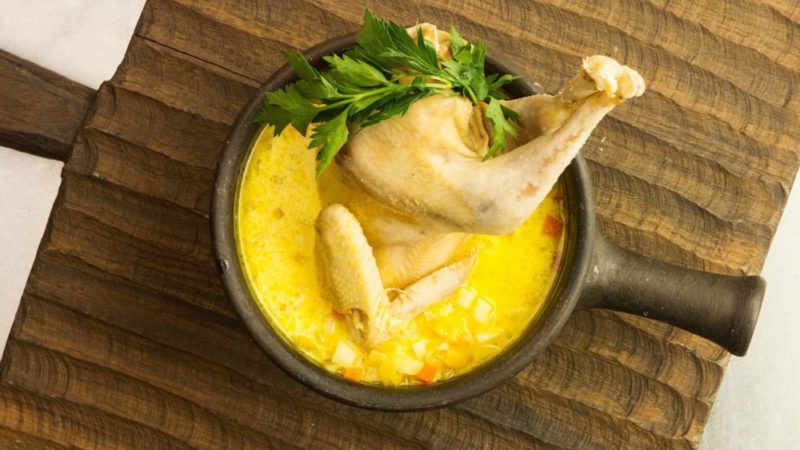Ossetian cuisine is fundamentally different from its global "colleagues." Its features are inspired by the romance of a nomadic lifestyle and endless freedom. Despite its relative poverty, these people managed to preserve and carry through the centuries the characteristic culinary features and traditional dishes.
Material Content:
History of Ossetian cuisine
The ancient ancestors of the Ossetians - Alans - made a great contribution to the formation of Ossetian cuisine. These are Iranian-speaking tribes that lived in movement. They constantly changed territories, that is, led a wandering lifestyle. From that time, the tradition of cooking in the cauldron stretched. On an open fire, the carcass of a ram or cow was saturated with smoke and became very fragrant. In the conditions of a campaign it was extremely convenient and practical. Today, a similar method of cooking is practiced as a tribute to history, but it has already been improved. Such a dish is now called “Ossetian meat”.
Not the best geographical location of Ossetians led to low security and a boring diet. A variety of yeast cakes served as hearty and relatively cheap food. They contained all kinds of fillings and everyone could choose the baked goods to taste: from salted potato with garlic to sweet pumpkin or cherry.
From ancient times, the tradition of three pies, which act as symbols of three saints: the Father and the Son, and the Holy Spirit, also stretched. Usually they were served on large Christian holidays and important feasts.
Traditions and Features
The tradition of treating guests with lamb or beef has survived to our times. Like the ancestors of the Alans, modern Ossetians cook it at the stake, but now not in the pot, but on the barbecue. The marinade for such a barbecue is dairy products, beer, herbs, sea salt and spices.
In addition to meat, Ossetian dishes include products such as:
- cabbage;
- pumpkin;
- potatoes;
- wild garlic;
- beet;
- cheese.
Pie recipes also have not sunk into oblivion and have become family values that are passed from one generation to another.
As a rule, Ossetians prefer cheese or meat baking. A prayer is read above it and only after that the family can start a meal.
What other good cooks of Ossetia are in the preparation of sour cream sauces. It would seem that it is practically impossible to diversify this supplement, but Ossetians manage to create more and more new variations by adding lemon juice, garlic, cucumber, walnut, adjika, mustard, parsley. Of the spices they use black and red pepper, coriander or dried dill.
Popular national dishes
Glorious Ossetian pies are distinguished by a wide selection, but one of the most popular is fydzhyn. This is a fragrant closed baking, which is placed in the center of the table both on holidays and on weekdays. The dough is prepared on the basis of yeast, the filling is traditionally meat: beef or, less commonly, veal. It should always be at least twice as large as the test. The secret of cooking is the broth, which is a little poured into the minced meat. It is he who makes the dish juicy, with a bright and memorable taste.
Another Ossetian delicacy is dzikka. It is a slurry of flour, soft cheese and sour cream. Such food was considered ritual: dzikka was alms to the deity of fertility Falvara. Today, this cheese mass is served as a side dish for the main dishes.
Not the last place in Ossetian cuisine is also occupied by meat dishes. Shish kebab mutton called "physonag" is pickled in ayran (or kefir). Spices, onions and fresh tomatoes only add a delicious touch of food. Modern chefs are increasingly moving away from the original and go to the trick, using pork instead of lamb. Such meat is more nutritious and juicy.
Products of own production
The national cuisine of Ossetia is rich not only in homemade dishes, but is also famous for quality products of its own production. For example, beer, which, according to legend, was invented by the main character of the Nart Ossetian epos, is estimated far beyond the borders of this country. For example, in Russia and in the north of the Caucasus. Foreign tourists highly appreciate its taste.
Of alcoholic beverages are also popular:
- rong;
- araka;
- double;
- plaster;
- Braga.
At the same time, excellent kvass is being made in Ossetia, which both visitors and locals are not against.
The lion's share of Ossetian cheeses is used in local culinary practice. But, in parallel with this, entrepreneurs export a small part of the product to other regions.
The abundance of cheese is due to the location of the country mainly in the mountains. In such conditions, local residents found it practical to keep sheep, goats and cows.
The gastronomy of Ossetia is focused not on the number of dishes, but on their quality. Therefore, visiting this small but proud country is definitely worth trying the local goodies. Centuries-old experience and sincere contribution will not leave indifferent even the most demanding traveler.















